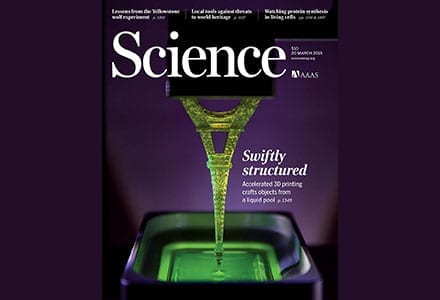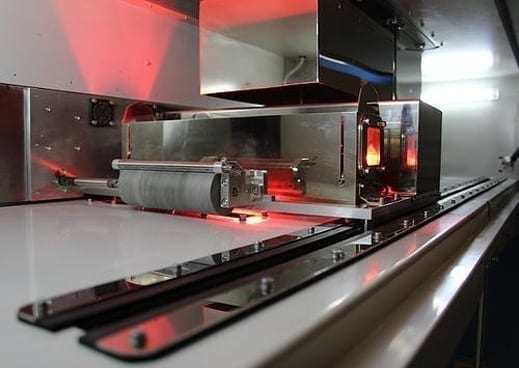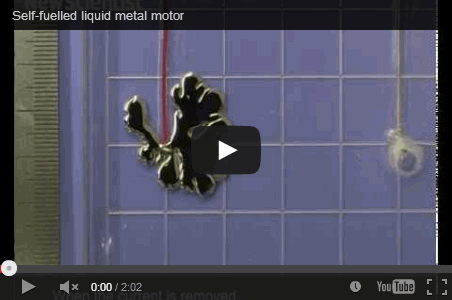
Allows ready-to-use products to be made 25 to 100 times faster
A 3-D printing technology developed by Silicon Valley startup, Carbon3D Inc., enables objects to rise from a liquid media continuously rather than being built layer by layer as they have been for the past 25 years, representing a fundamentally new approach to 3-D printing. The technology, to appear as the cover article in the March 20 print issue of Science, allows ready-to-use products to be made 25 to 100 times faster than other methods and creates previously unachievable geometries that open opportunities for innovation not only in health care and medicine, but also in other major industries such as automotive and aviation.
Joseph M. DeSimone, professor of chemistry at UNC-Chapel Hill and of chemical engineering at N.C. State, is currently CEO of Carbon3D where he co-invented the method with colleagues Alex Ermoshkin, chief technology officer at Carbon 3D and Edward T. Samulski, also professor of chemistry at UNC. Currently on sabbatical from the University, DeSimone has focused on bringing the technology to market, while also creating new opportunities for graduate students to use the technique for research in materials science and drug delivery at UNC and NCSU.
The technology, called CLIP — for Continuous Liquid Interface Production — manipulates light and oxygen to fuse objects in liquid media, creating the first 3-D printing process that uses tunable photochemistry instead of the layer-by-layer approach that has defined the technology for decades. It works by projecting beams of light through an oxygen-permeable window into a liquid resin. Working in tandem, light and oxygen control the solidification of the resin, creating commercially viable objects that can have feature sizes below 20 microns, or less than one-quarter of the width of a piece of paper.
“By rethinking the whole approach to 3-D printing, and the chemistry and physics behind the process, we have developed a new technology that can create parts radically faster than traditional technologies by essentially ‘growing’ them in a pool of liquid,” said DeSimone, who was scheduled to reveal the technology at a TED talk on March 16 in the opening session of the conference in Vancouver, British Columbia.
Through a sponsored research agreement between UNC-Chapel Hill and Carbon 3D, the team is currently pursuing advances to the technology, as well as new materials that are compatible with it. CLIP enables a very wide range of material to be used to make 3D parts with novel properties, including elastomers, silicones, nylon-like materials, ceramics and biodegradable materials. The technique itself provides a blueprint for synthesizing novel materials that can further research in materials science.
Read more: UNC-Chapel Hill researchers collaborate to develop 3-D printing technology
The Latest on: 3-D printing
[google_news title=”” keyword=”3-D printing” num_posts=”10″ blurb_length=”0″ show_thumb=”left”]
via Google News
The Latest on: 3-D printing
- US signs Aerojet to 3D-print hypersonic propulsion system prototypeon May 9, 2024 at 1:44 am
Aerojet Rocketdyne has been given a contract by the US Department of Defense (DoD) to develop a hypersonic propulsion prototype through additive manufacturing. The $22 million contract from the DoD ...
- MTC installs Lithoz CeraFab S65 machine to drive industrial ceramic 3D printing in the UKon May 9, 2024 at 1:24 am
The Manufacturing Technology Centre (MTC), the UK’s national centre for additive manufacturing, has installed a Lithoz CeraFab S65 3D printer.
- Massivit to Launch Affordable Large-Format 3D Printer at drupa 2024 International Printing Show in Germanyon May 8, 2024 at 5:27 am
The Highly Anticipated Massivit 3000 Printer Provides an Affordable, High-Performance 3D Printing Solution for Print Service Providers and Entertainment Fabricators. LOD, Israel, ...
- Camhirst Robots Introduces Innovative 3D Construction Printing Technology in Greater Manchester to Address Global Housing Shortageon May 8, 2024 at 12:34 am
Positioned in the heart of Greater Manchester, the company is poised to revolutionize global home construction with its advanced 3D Construction Printing Robots. Adam Ahmed Camhirst CEO with ...
- MIT spin-off Rapid Liquid Print raises $7M for 3D printingon May 7, 2024 at 1:30 pm
MIT spin-off Rapid Liquid Print has raised $7 million in funding for its novel liquid-based 3D printing technology.
- This gigantic 3D printer could reinvent manufacturingon May 7, 2024 at 2:00 am
A massive additive manufacturing device that can build houses, and a whole lot more has just been unveiled at the University of Maine.
- HKPC and HP Launch Joint Technology Centre in Hong Kong on Advanced 3D Printingon May 7, 2024 at 12:03 am
HONG KONG, May 7, 2024 /PRNewswire/ -- Hong Kong Productivity Council (HKPC) and HP signed a collaboration agreement (agreement) today to establish the HKPC-HP 3D Printing Technology Centre (Centre) ...
- FFF 3D Printing: Can New Nozzle Technology Replace Resin Printers?on May 3, 2024 at 2:47 pm
Do you need a resin 3D printer when FFF devices now approach similar levels of surface quality? That sounds like a crazy question. For many years it’s been 3D print gospel that resin equipment ...
- 3D Printing Finds a Homeon May 2, 2024 at 8:49 am
“Prefabricated 3D printed homes reduce the amount of labor required to build a home, thereby making homes safer, potentially cheaper, and much faster from design to completion,” says Buff López, an ...
- Study unveils 3D printing PQD-polymer architectures at room temperatureon May 2, 2024 at 7:52 am
A technology enabling the fabrication of intricate three-dimensional (3D) quantum dot (QD)-based structures at room temperature has been developed.
via Bing News










